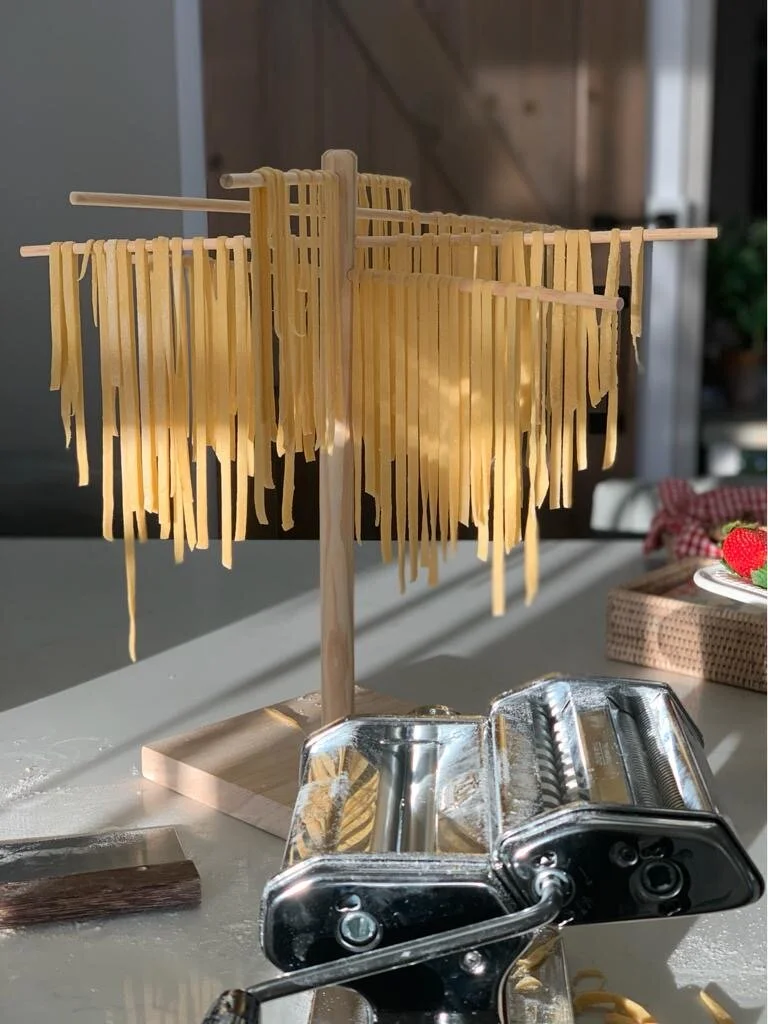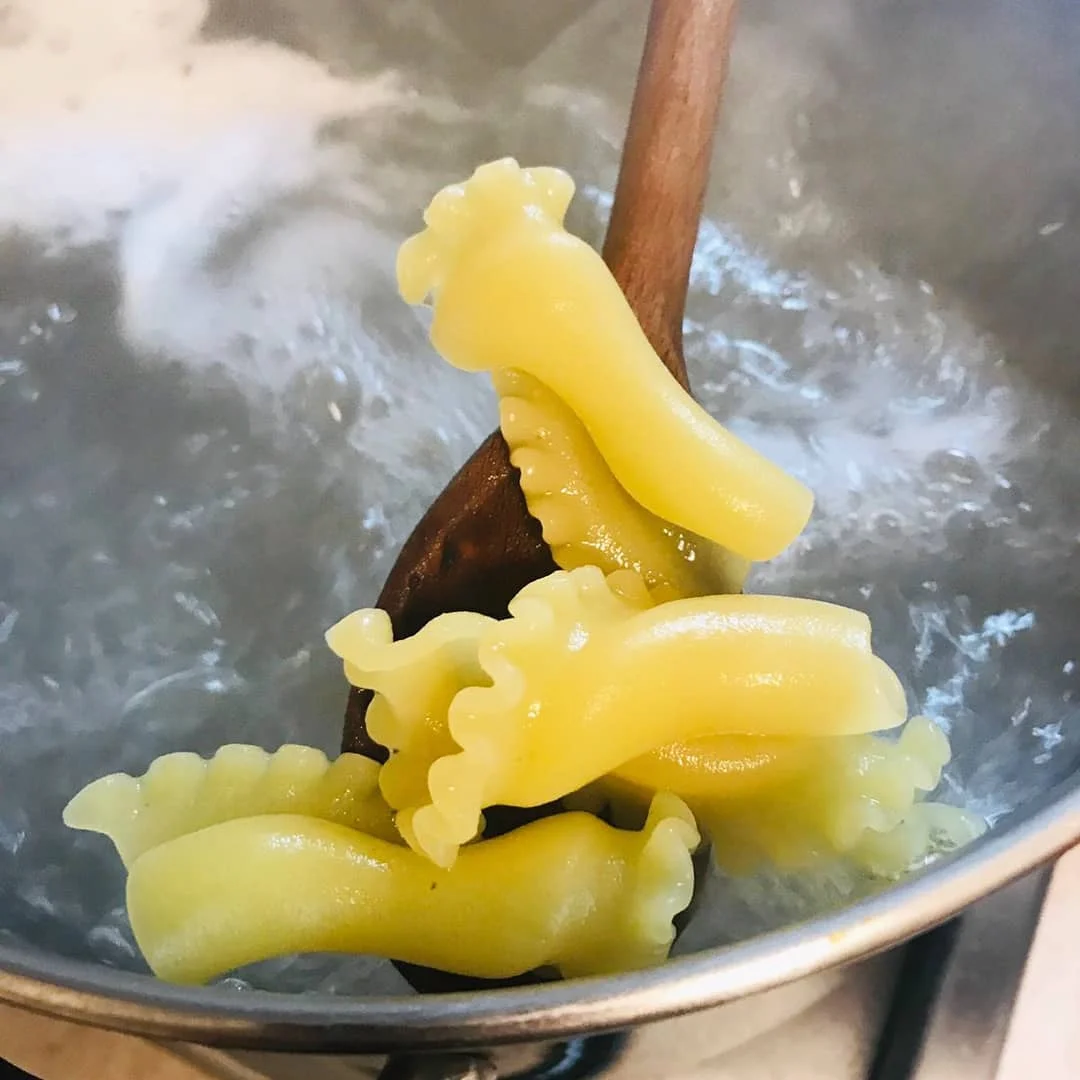Fresh Pasta: Recipe, Tips & Tricks
My first attempt at making fresh pasta was a resounding failure. I learned from an old spinster in the mountain hamlet of Agerola perched high above the Amalfi Coast. As I watched her crack an egg into a well of flour and effortlessly form a pliable dough, it all looked so easy.
After refrigerating the dough, she folded it into a compact envelope and fed it through a manual pasta roller, gradually producing long strands of lasagna noodles. In a matter of minutes, she had shaped and stuffed 2 dozen spinach ricotta ravioli, using nothing more than a dough scraper. She loaned me her pasta roller to practice at home, telling me simply, “è facile….it’s easy!”
It was not!
Jotting down my notes from this zitella spinster friend, I then ran home to make my first batch of fresh pasta. I fetched eggs from our chicken coop, poured a mound of flour onto a long farmhouse table and eagerly got to work. My then husband’s 90 year old mother sat in a plastic lawn chair in the corner of our ramshackle kitchen eyeing me suspiciously.
I imitated my friend’s confident movements, fruitlessly attempting to incorporate the eggs into the flour. My hands were sticky, long tendrils of goop sagging from my fingers. As I tried to look at my notes, smears of sticky paste clung to the table. My mother-in-law remained silent. Just as I attempted to force a raggedy lump of slime through the loaned pasta roller, she finally leapt out of her chair and yelped her familiar refrain, “famme fa' a mè …just let me do it.”
In minutes she had swiftly rectified the situation, dusting my sorry lump with flour and confidently folding it into a golden disk. F*ck this lady was good. I hated to admit it, but my mother-in-law knew her way around a kitchen. Every time she schooled me , I hung my head and muttered in defeat, “hai raggione, you’re right…” Like most old Italian ladies, she lived for those moments of culinary affirmation.
Years later, I have become a confident fresh pasta maker. In the beginning the source of my problems was simply that I was recklessly measuring my ingredients. Unfamiliar with the metric system and incapable of properly using a kitchen scale, I constantly miscalculated the ratio of egg to flour. Funny how the simplest things often foil us in the kitchen.
Mise en place is also essential to pasta making. You need a clean surface and proper tools. Though you don’t need any complex gadgets. The pasta roller and a dough scraper are usually sufficient. Some of the most iconic pasta shapes come from improvised kitchen equipment. Pencils and rods to make fusilli. Fork tines to shape gnocchi. Guitar strings to press maccheroni alla chitarra.
Truly, necessity is the mother of invention when shaping pasta in the humble Italian kitchen. Amazon will try to convince the budding pasta enthusiast to buy countless accoutrements. Resist the urge. Learn the basics and start simple.
One piece of equipment you will need is a hand-cranked pasta roller. Many standing mixtures will offer an attachment that rolls pasta. I don’t like them. The visceral delight in using a manual roller is a form of meditation I refuse to sacrifice to the kitchen gods of convenience. Once you learn to use your roller to form long strands of lasagna shaped pasta, you can graduate to forming more esoteric pasta shapes. Many of which are possible with the aid of a dough scraper and a ruler.
The other tool I cannot live without is a pasta tree. It took months of practice for me to understand why my pasta was clinging together in a tangled mess of medusa hair. I wasn’t taking care to store it properly before cooking it in boiling salted water. By draping each strand of freshly rolled pasta over a wooden pasta tree, you ensure the noodles don’t stick together. A scant dusting of semolina or corn meal also ensures a similar result. Space is your friend when making pasta. So is patience.
My recipe for egg pasta is roughly the same as nearly every other recipe I have learned over the years. Eggs, flour and olive oil. I use a standing mixer to form the dough. You can also use your hands.
Finally, don’t let perfection be the enemy of the good. When embarking on the new pathway towards fresh pasta cookery, it is tempting to go full tilt bozo. Instead of sticking to a simple pasta shape (like a lasagna noodle), I wanted to make squid ink and beet root tinted sheep’s milk ricotta ravioli. I mean really! No need to get baroque right out of the pasta making gate.
Make several batches of fresh lasagna and learn to work with it before graduating to something only slightly more complicated, like linguine. Piano, piano as we say in Italian. Slowly, slowly.
I’ll share our fresh lasagna sheet recipe below and note some of the most common mistakes in making a basic lasagna noodle. Think of the lasagna sheet as your fresh pasta building block. Essentially all fresh pastas start as a lasagna noodle before being transformed into something else. Master this and then build your repertoire.
Fresh Lasagna Sheet Recipe
Makes 16 Lasagna Sheets
Ingredients
3 organic room temperature eggs (The better the egg, the better the pasta! Look for eggs with a rich golden yolk.)
2 cups all-purpose or 00 flour (00 is best, but all purpose is just fine)
1 tablespoon extra-virgin olive oil
1 teaspoon kosher salt
Equipment
Stand Mixer
Dough Scraper
French Rolling Pin
Hand-cranked pasta roller
Pasta Tree
Tongs or Spider Strainer
Instructions
Place all ingredients in the bowl of a stand mixer fitted with the hook attachment
Turn speed to medium low (2-3 on Kitchen Aid Mixer) and kneed for 10 minutes (a shaggy NOT sticky dough will form)
Remove the pasta from bowl and form into a flattened ball
Cover with plastic wrap and refrigerate for 30 minutes
Remove from refrigerator, and cut into four equal pieces using dough scraper
Roll each quarter into a flattened oval
Clamp the pasta roller to you work surface and feed dough through setting 0
As you roll through first time, fold dough into rectangular envelope and feed through setting 0 again
After feeding through setting 0, gradually feed through setting 1 (It is critical you do not jump settings. The dough will curl and tear if you attempt to skip thickness settings).
Feed through setting 1 three times, gradually building through each setting all the way to setting 6 (Even if you think the dough is ready, it is probably not thin enough. Go again. You may need to cut your dough in half horizontally or you will end up with on two foot long lasagna noodle).
After finishing each sheet of lasagna, drape over the arms of pasta tree
You can dust in semolina and dry for later use or cut into another pasta shape such as linguine or ravioli
Repeat with each pasta oval
To boil fresh pasta, bring a pot of salted water to boil
Add olive oil to the water as it reaches boil (The olive oil will prevent the fresh pasta from sticking together. You ONLY use olive oil if you are boiling fresh pasta!)
Once the water reaches a boil, add two to three lasagna sheets at a time, boiling until each rise to the surface (about 30 seconds)
Working in batches, boil lasagna sheets and remove with tongs or spider strainer
Place cooked lasagna sheets in a single layer on a platter (If you attempt to cook all of the lasagna sheets at once and drain into a colander, they will stick together!)
Use lasagna sheets to make Bolognese or Neapolitan Lasagna. If you have leftover sheets, you can cut into rustic squares and make Pasta e Fagioli
Top 10 Most Common Fresh Pasta Making Mistakes
1) Too much flour or not enough
Too much flour makes the pasta tough. Not enough will result in runny lumps that are impossible to roll through pasta maker.
2) Failing to rest the dough
If you fail to rest the dough for thirty minutes in the refrigerator, it will be shaggy and unincorporated
3) Over aggressive rolling
When you roll through pasta settings too quickly, the pasta will tear and ruffle, producing uneven sheets
4) Drying in a careless clump
After you have taken the care to roll the pasta, you need to properly store it until later use. If it sits together in a pile, it will stick and cling like play dough
5) Rolling too thick or too thin
Lasagna sheets are rolled to setting 6 or 7 on a hand-cranked pasta roller. If you roll too thick the result is cakey. If you roll too thin, the noodle may break.
6) Improper shaping of the dough
Be sure to fold and shape the dough into manageable and clean rectangles before feeding through the roller. Sometime you may need to trim excess. The key is to produce clean straight lines of lasagna sheets. It is ok to be rustic. But remember you are producing a sheet, not a trapezoid.
7) No olive oil in boiling water
Your noodles will stick and all your hard work will have gone to waste.
8) Too many noodles in boiling water
Your noodles will stick and all your hard work will have gone to waste.
9) Dumping your noodles into a colander
Your noodles will stick and all your hard work will have gone to waste.
10) Allowing cooked noodles to rest in pile
Your noodles will stick and all your hard work will have gone to waste.
Treat your fresh pasta with care and your hard work will result in a superior, delicate lasagna. You will never buy dry lasagna sheets again.






